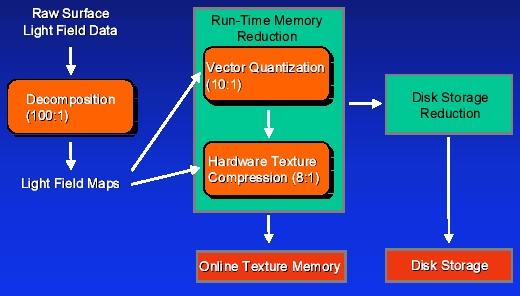Hardware Acceleration
Hardware support requires both multitexturing and register combine functions for optimum efficiency.
Multitexturing requires approximately one rendering pass per triangle-centered term, while vector-centered terms
require three passes at minimum. Register combiners found with current high-end video chipsets like nVidia's
GeForce-3 extends hardware acceleration for color range and texture modulation support. Most other operations
can be executed through either programmable video card transform and lighting routines or custom software through
the primary system processor.
Light Field Map Compression

Since light field maps are essentially texture data with many redundant patterns, common texture compression
formats can be introduced to limit memory requirements to manageable levels for real-time rendering. A combination
of S3 texture compression and vector quantization offers four levels of data compression when combined with the
earlier described decomposition through approximation and truncation techniques.

The above chart represents the compression characteristics of a few of the scene models employed for this article.
The results are quite impressive as each scene is reduced from multiple gigabytes of raw data to just a few kilobytes
of stored information. Considering the small size of each light map, it can be assumed that multiple light
maps could be generated for multiple objects while retaining real-time frame rate performance with even current
generation hardware.
Final Thoughts
Intel has been a long-time developer of three dimensional computer rendering technologies, even though most
agree this company's actual integrated 3D hardware products are generally considered to be sub-par at best.
Regardless, Intel appears to be on track with a viable solution for increasing visuals while retaining sustainable
performance for real-time response.
Preview Clip
And to conclude, a low-resolution preview clip of a software model using Light Field Mapping is available for viewing
here.
(Right click to save, video encoded with DivX 4.01) |

